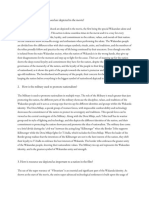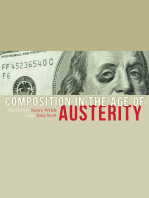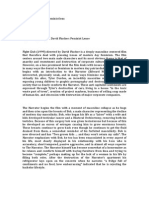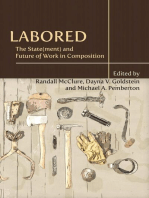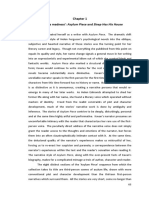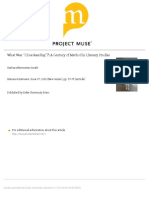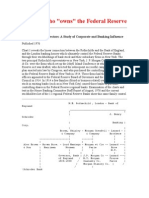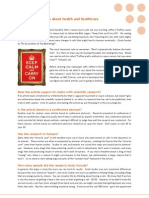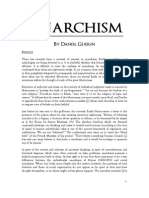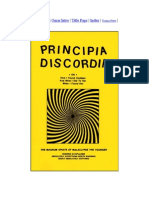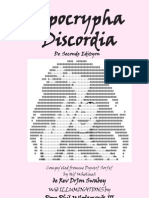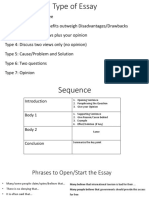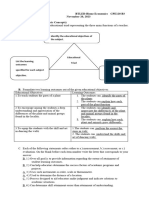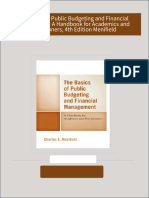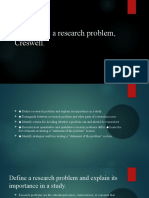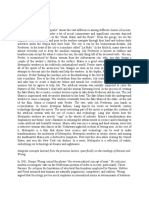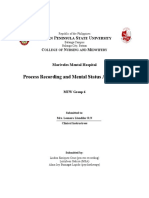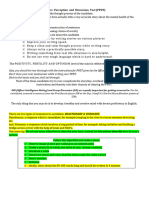Logical Fallacies Infographic
Logical Fallacies Infographic
Uploaded by
gonzomarxCopyright:
Available Formats
Logical Fallacies Infographic
Logical Fallacies Infographic
Uploaded by
gonzomarxCopyright
Available Formats
Share this document
Did you find this document useful?
Is this content inappropriate?
Copyright:
Available Formats
Logical Fallacies Infographic
Logical Fallacies Infographic
Uploaded by
gonzomarxCopyright:
Available Formats
A logical fallacy is often what has happened when someone is wrong about something. It's a aw in reasoning.
They're like tricks or illusions of thought, and they're often very sneakily used by politicians, the media, and others to fool people.
Dont be fooled! This poster has been designed to help you identify and call out dodgy logic wherever it may raise its ugly, incoherent head. If you see someone committing a logical fallacy online, link them to the relevant fallacy
to school them in thinky awesomeness e.g. yourlogicalfallacyis.com/strawman. More in-depth explanations and examples of these fallacies can also be found at the website.
This poster is published under a Creative Commons No Derivative Works license 2012 by Jesse Richardson. You are free to print, copy, and redistribute this artwork, including printing and selling for prot, with the binding proviso that you reproduce it in full so that others may share alike. This poster can be downloaded as a high resolution pdf from the website for printing at various sizes.
Misrepresenting or
exaggerating someones
argument to make it easier
to attack.
Cherry-picking data clusters
to suit an argument, or nding
a pattern to t a presumption.
Attacking your opponents
character or personal traits
instead of engaging with
their argument.
Asking a question that has an
assumption built into it so that
it cant be answered without
appearing guilty.
Believing that runs occur to
statistically independent
phenomena such as roulette
wheel spins.
Appealing to popularity or the
fact that many people do
something as an attempted
form of validation.
Where two alternative states
are presented as the only
possibilities, when in fact more
possibilities exist.
A circular argument in which
the conclusion is included in
the premise.
Using the opinion or position
of an authority gure, or
institution of authority, in
place of an actual argument.
Making the argument that
because something is natural
it is therefore valid, justied,
inevitable, or ideal.
Assuming that whats true
about one part of something
has to be applied to all,
or other, parts of it.
Using personal experience or
an isolated example instead of
a valid argument, especially to
dismiss statistics.
Making what could be called
an appeal to purity as a way to
dismiss relevant criticisms or
aws of an argument.
Saying that a compromise,
or middle point, between two
extremes is the truth.
Judging something good
or bad on the basis of where
it comes from, or from
whom it comes.
Using double meanings
or ambiguities of language
to mislead or misrepresent
the truth.
Presuming that a real or
perceived relationship
between things means that
one is the cause of the other.
Presuming that because a
claim has been poorly argued,
or a fallacy has been made,
that it is necessarily wrong.
Manipulating an emotional
response in place of a valid or
compelling argument.
Avoiding having to engage
with criticism by turning it
back on the accuser -
answering them with criticism.
Saying that the burden of proof
lies not with the person
making the claim, but with
someone else to disprove.
Saying that because one nds
something difcult to
understand that its therefore
not true.
Moving the goalposts or
making up exceptions when a
claim is shown to be false.
Asserting that if we allow
A to happen, then Z will
consequently happen too,
therefore A should not happen.
You might also like
- Above the Well: An Antiracist Literacy Argument from a Boy of ColorFrom EverandAbove the Well: An Antiracist Literacy Argument from a Boy of ColorNo ratings yet
- Black Panther - Film Study.Document7 pagesBlack Panther - Film Study.harsimar.singhtonyNo ratings yet
- Rhetorical Device Journal - Sinners in The Hands of An Angry GodDocument3 pagesRhetorical Device Journal - Sinners in The Hands of An Angry GodAndy CampbellNo ratings yet
- Picture Wrorth 100 WordsDocument16 pagesPicture Wrorth 100 Wordslenig1No ratings yet
- Bob Altmeyer - The AuthoritariansDocument261 pagesBob Altmeyer - The Authoritarianszoidbergh77No ratings yet
- How NOT To CookbookDocument321 pagesHow NOT To Cookbookgonzomarx75% (4)
- A Selection of Obscure Robert Anton Wilson EssaysDocument22 pagesA Selection of Obscure Robert Anton Wilson Essaysgonzomarx100% (3)
- Business Strategy Reflective Report: RD THDocument3 pagesBusiness Strategy Reflective Report: RD THNicK OnGNo ratings yet
- (English (Auto-Generated) ) TEDxDartmouth 2011 - Michael Chaney - How To Read A Graphic Novel - March 6, 2011 (DownSub - Com)Document3 pages(English (Auto-Generated) ) TEDxDartmouth 2011 - Michael Chaney - How To Read A Graphic Novel - March 6, 2011 (DownSub - Com)Camila GonzalezNo ratings yet
- Fight Club Through A Feminist LensDocument3 pagesFight Club Through A Feminist LensFigenKınalıNo ratings yet
- Jane Shaffer Writing Style InfoDocument1 pageJane Shaffer Writing Style InfoEmaanHaqueNo ratings yet
- Literary Publishing in the Twenty-First CenturyFrom EverandLiterary Publishing in the Twenty-First CenturyTravis KurowskiNo ratings yet
- EX LIBRIS: Commonplace BooksDocument2 pagesEX LIBRIS: Commonplace BooksToronto1230% (2)
- Allegory and ParodyDocument4 pagesAllegory and ParodyVERTURICANo ratings yet
- Reading Chinese Fortune Cookie: The Making of Chinese American RhetoricFrom EverandReading Chinese Fortune Cookie: The Making of Chinese American RhetoricNo ratings yet
- "I See Every Thing As You Desire Me To Do": The Scolding and Schooling of Marianne DashwoodDocument13 pages"I See Every Thing As You Desire Me To Do": The Scolding and Schooling of Marianne DashwoodYair Branco Berríos NúñezNo ratings yet
- Send My Love and a Molotov Cocktail!: Stories of Crime, Love and RebellionFrom EverandSend My Love and a Molotov Cocktail!: Stories of Crime, Love and RebellionRating: 2.5 out of 5 stars2.5/5 (1)
- Triggered Literature: Triggered Literature: Cancellation, Stealth Censorship and Cultural WarfareFrom EverandTriggered Literature: Triggered Literature: Cancellation, Stealth Censorship and Cultural WarfareNo ratings yet
- Creepy Short Horror Stories To Read To The Creature In The ClosetFrom EverandCreepy Short Horror Stories To Read To The Creature In The ClosetNo ratings yet
- Oscar Wilde, Art and Morality: A Defence of "The Picture of Dorian Gray"From EverandOscar Wilde, Art and Morality: A Defence of "The Picture of Dorian Gray"No ratings yet
- Poetry Analysis 101: The Ultimate Guide To Understanding PoetryDocument18 pagesPoetry Analysis 101: The Ultimate Guide To Understanding PoetryGemma ManalastasNo ratings yet
- Cherished: 21 Writers on Animals They Have Loved and LostFrom EverandCherished: 21 Writers on Animals They Have Loved and LostNo ratings yet
- Writing Toolbox (Guidelines)Document139 pagesWriting Toolbox (Guidelines)QiLin Xue - John Fraser SS (2652)No ratings yet
- Critical Essay On Anna Kavan and Asylum PieceDocument38 pagesCritical Essay On Anna Kavan and Asylum PieceAndrew KendallNo ratings yet
- What Was Close Reading A Century of Meth PDFDocument20 pagesWhat Was Close Reading A Century of Meth PDFAntonio Marcos PereiraNo ratings yet
- Gothic Things: Dark Enchantment and Anthropocene AnxietyFrom EverandGothic Things: Dark Enchantment and Anthropocene AnxietyNo ratings yet
- Themes VignettesDocument6 pagesThemes Vignettesapi-327029938No ratings yet
- Tales of the Grotesque and Arabesque: "Words have no power to impress the mind without the exquisite horror of their reality."From EverandTales of the Grotesque and Arabesque: "Words have no power to impress the mind without the exquisite horror of their reality."No ratings yet
- Your Life Is Your LifeDocument1 pageYour Life Is Your LifegonzomarxNo ratings yet
- The White RoseLeaflet #2Document1 pageThe White RoseLeaflet #2gonzomarxNo ratings yet
- Chart of Who Owns The Federal ReserveDocument9 pagesChart of Who Owns The Federal ReserveSUPPRESS THIS100% (6)
- How To Read A News Story About Health and HealthcareDocument2 pagesHow To Read A News Story About Health and HealthcaregonzomarxNo ratings yet
- The AlchemistsDocument7 pagesThe AlchemistsZerohedgeNo ratings yet
- The Surre (Gion) Alist Manifesto and Other WritingsDocument135 pagesThe Surre (Gion) Alist Manifesto and Other Writingsgonzomarx100% (3)
- Everyone's Guide To By-Passing Internet CensorshipDocument31 pagesEveryone's Guide To By-Passing Internet Censorshipanon-591129100% (9)
- Matt Taibbi The Big TakeoverDocument21 pagesMatt Taibbi The Big Takeovergonzomarx100% (1)
- Anarchism: by Daniel GuerinDocument47 pagesAnarchism: by Daniel GuerinSmarth100% (1)
- A Short History of MoneyDocument22 pagesA Short History of MoneygonzomarxNo ratings yet
- Principia DiscordiaDocument121 pagesPrincipia DiscordiaCainAerte93% (14)
- Discordian - Apocrypha DiscordiaDocument100 pagesDiscordian - Apocrypha DiscordiaJosh Ninetythree Sands100% (2)
- Dirty Secrets of The Temple - How The Federal Reserve Runs The USDocument13 pagesDirty Secrets of The Temple - How The Federal Reserve Runs The USgonzomarx100% (1)
- Universal Declaration of Human RightsDocument8 pagesUniversal Declaration of Human RightselectedwessNo ratings yet
- Dynamic EtherDocument7 pagesDynamic EthergonzomarxNo ratings yet
- Question TechnicalDocument9 pagesQuestion TechnicalTuân NgọcNo ratings yet
- GROW - Bulletin - Learner AssessmentDocument9 pagesGROW - Bulletin - Learner Assessmentrethabilesikhosana6No ratings yet
- Lesson The Physical SelfDocument10 pagesLesson The Physical SelfEdison Lati Jr.No ratings yet
- As Biology Edexcel Coursework Mark SchemeDocument4 pagesAs Biology Edexcel Coursework Mark Schemeafjwfealtsielb100% (2)
- Writing Task 2 TemplateDocument16 pagesWriting Task 2 TemplateAsibNo ratings yet
- Lesson 1 Entrepreneurship 1Document49 pagesLesson 1 Entrepreneurship 1Mary Claire SialongoNo ratings yet
- Critical Analysis of The Schwartz Value SurveyDocument6 pagesCritical Analysis of The Schwartz Value SurveyHappy DirigeNo ratings yet
- Lesson 1 ExercisesDocument5 pagesLesson 1 ExerciseshatashikakachiNo ratings yet
- Chapter 16 Sex Gender, and PersonalityDocument33 pagesChapter 16 Sex Gender, and PersonalityMUHAMAD HAIKAL DANIAL BIN CHE MOHD NOR A22HP0081No ratings yet
- The Basics of Public Budgeting and Financial Management: A Handbook for Academics and Practitioners, 4th Edition Menifield All Chapters Instant DownloadDocument40 pagesThe Basics of Public Budgeting and Financial Management: A Handbook for Academics and Practitioners, 4th Edition Menifield All Chapters Instant Downloadnodencoteyfb100% (4)
- Parent Teacher Partnership Towards Early Literacy and Numeracy DevelopmentDocument39 pagesParent Teacher Partnership Towards Early Literacy and Numeracy DevelopmentMelanie CantreNo ratings yet
- Identifying A Research Problem, CreswellDocument10 pagesIdentifying A Research Problem, CreswellClaudia OvalleNo ratings yet
- Solución EvAU Madrid Inglés 2023 Junio Opción B CienciasDocument3 pagesSolución EvAU Madrid Inglés 2023 Junio Opción B Cienciasceliabernal06No ratings yet
- Structural Design For OrganizationDocument2 pagesStructural Design For OrganizationVivek PNo ratings yet
- Research Paper Rubric-Free-Sample PDFDocument1 pageResearch Paper Rubric-Free-Sample PDFDennis RañonNo ratings yet
- EDU433 Final Term 10 Paper 2023-2024 by Everblue 2024Document33 pagesEDU433 Final Term 10 Paper 2023-2024 by Everblue 2024sanam.khang.bzuNo ratings yet
- Metropolis MovieDocument2 pagesMetropolis MovieNaeemah ApionNo ratings yet
- Psychiatric Nursing IIIDocument92 pagesPsychiatric Nursing IIIlorryleenNo ratings yet
- GE5 Module 2 Lesson 1Document8 pagesGE5 Module 2 Lesson 1Cyd LaurenceNo ratings yet
- #6 Style Lesson 6 EmphasisDocument26 pages#6 Style Lesson 6 Emphasisrocking831114No ratings yet
- Psychic - EXACT BLUEPRINT On How To Develop Psychic Abilities and Explode Open Your Intuition - Telepathy, Fortune Telling, ESP & Mind Reading (Clairvoyance, Psychic Medium, Third Eye, Palmistry)Document118 pagesPsychic - EXACT BLUEPRINT On How To Develop Psychic Abilities and Explode Open Your Intuition - Telepathy, Fortune Telling, ESP & Mind Reading (Clairvoyance, Psychic Medium, Third Eye, Palmistry)Koop Da Ville100% (11)
- Oil Refinery Maintenance Interview Questions Answers GuideDocument14 pagesOil Refinery Maintenance Interview Questions Answers GuideSingh Aditya SinghNo ratings yet
- 01 - Picture Perception Test SSBDocument25 pages01 - Picture Perception Test SSBSulabh SahNo ratings yet
- Good To Great by Jim Collins - Book Summary by Paul MinorsDocument17 pagesGood To Great by Jim Collins - Book Summary by Paul MinorsAziz ur RehmanNo ratings yet
- Business Letter ReportDocument25 pagesBusiness Letter ReportEshel BaculodNo ratings yet
- Part I: The Connection Between Fads and TrendsDocument12 pagesPart I: The Connection Between Fads and TrendsAlyanna Gutierrez50% (2)
- PR Marwin (12594)Document7 pagesPR Marwin (12594)Denmark MandrezaNo ratings yet
- Analisis Kurikulum Berbasis Kompetensi Fkui 2005Document43 pagesAnalisis Kurikulum Berbasis Kompetensi Fkui 2005adibyanNo ratings yet
- English 10: Dalig National High SchoolDocument3 pagesEnglish 10: Dalig National High SchoolRhine CrbnlNo ratings yet

